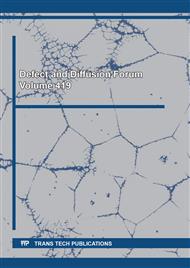[1]
A.A. Asheichik, A.A. Samsonenko, Research of the driven capacity of pushers with rubber pads for oil equipment, IOP Conf. Ser.: Mater. Sci. Eng. 666 (2019) 012002.
DOI: 10.1088/1757-899x/666/1/012002
Google Scholar
[2]
A.A. Asheichik, M.R. Bahrami, Prediction of leakage in the fixed mechanical seal, MATEC Web of Conferences. 129 (2017) 06002.
DOI: 10.1051/matecconf/201712906002
Google Scholar
[3]
A.A. Asheichik, M.R. Bahrami, Investigation of Graflon antifriction feature under friction in seawater. Procedia Engineering. 206 (2017) 642-646.
DOI: 10.1016/j.proeng.2017.10.530
Google Scholar
[4]
A.I. Rudskoy, O.V. Tolochko, T.S. Kol'tsova, A.G. Nasibulin, Synthesis of carbon nanofibers on the surface of particles of aluminum powder. Metal Science and Heat Treatment. 55(9-10) (2014) 564-568.
DOI: 10.1007/s11041-014-9670-8
Google Scholar
[5]
T.A. Larionova, T.S. Koltsova, Y.A. Fadin, O.V. Tolochko, Friction and wear of copper–carbon nanofibers compact composites prepared by chemical vapor deposition. Wear. 319(1-2) (2014) 118-22.
DOI: 10.1016/j.wear.2014.07.020
Google Scholar
[6]
V.N. Tsemenko, O.V. Tolochko, T.S. Kol'tsova, S.V. Ganin, V.G. Mikhailov, Fabrication, structure and properties of a composite from aluminum matrix reinforced with carbon nanofibers. Metal Science and Heat Treatment. 60 (2018) 24-31.
DOI: 10.1007/s11041-018-0235-0
Google Scholar
[7]
V.M. Lebedev, V.M. Radchenko, Study of wear resistance of tribojunctions operating in the boundary lubrication regime, Trenie i Iznos. 5(5) (1984) 146-149.
Google Scholar
[8]
V.M. Lebedev, Study of the anti-frictional properties metal-filled vulcanisates based on SKF-32 in use under vacuum, Kauchuk i Rezina. 6 (1981) 33-35.
Google Scholar
[9]
M.R. Bahrami, Nonlinear dynamic analysis of non-contact atomic force microscope, 2020 4th Scientific School on Dynamics of Complex Networks and their Application in Intellectual Robotics (DCNAIR), 2020, pp.49-52.
DOI: 10.1109/dcnair50402.2020.9216887
Google Scholar
[10]
M.R. Bahrami, A.W. Abeygunawardana, Modeling and simulation of dynamic contact atomic force microscope, in: A. Evgrafov (Eds), Advances in Mechanical Engineering. Lecture Notes in Mechanical Engineering. Springer, Cham, 2019.
DOI: 10.1007/978-3-030-11981-2_10
Google Scholar
[11]
A.D. Breki, M. Nosonovsky, Ultraslow frictional sliding and the stick-slip transition, Applied Physics Letters. 113(24) (2018) 241602.
DOI: 10.1063/1.5064820
Google Scholar
[12]
A.D. Breki, A.L. Didenko, V.V. Kudryavtsev, E.S. Vasilyeva, O.V. Tolochko, A.G. Kolmakov et al., Synthesis and dry sliding behavior of composite coating with (R–OOO) FT polyimide matrix and tungsten disulfide nanoparticle filler, Inorganic Materials: Applied Research. 8(1) (2017) 32-36.
DOI: 10.1134/s2075113317010063
Google Scholar
[13]
A.D. Breki, S.E. Aleksandrov, K.S. Tyurikov, A.G. Kolmakov, A.E. Gvozdev, A.A. Kalinin, Antifriction properties of plasma-chemical coatings based on SiO2 with MoS2 nanoparticles under conditions of spinning friction on ShKh15 steel, Inorganic Materials: Applied Research. 9(4) (2018) 714-718.
DOI: 10.1134/s2075113318040081
Google Scholar
[14]
A.D. Breki, M. Nosonovsky, Einstein's viscosity equation for nanolubricated friction. Langmuir. 34(43) (2018) 12968-12973.
DOI: 10.1021/acs.langmuir.8b02861
Google Scholar
[15]
Y.A. Fadin, O.F. Kireenko, S.V. Sychev, A.D. Breki, Acoustic emission and surface roughness of brittle materials, Technical Physics Letters. 40(12) (2014) 1089-1091.
DOI: 10.1134/s1063785014120232
Google Scholar
[16]
A.Y. Bashkarev, V.V. Bukreev, A.V. Kuschenko, A.V. Stukach, Adhesive bonding strength of polyamide coating on steel substrate in friction units of machines, International Review of Mechanical Engineering. 11(9) (2017) 673-676.
DOI: 10.15866/ireme.v11i9.11595
Google Scholar
[17]
A.N. Evgrafov, G.N. Petrov, Self-braking of planar linkage mechanisms, Lecture Notes in Mechanical Engineering. (2018) 83-92.
DOI: 10.1007/978-3-319-72929-9_10
Google Scholar


